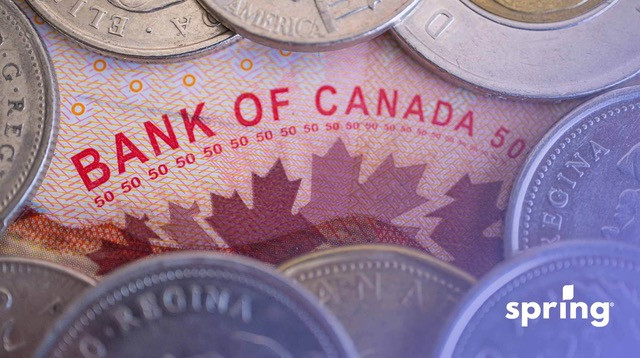While the federal tax brackets are the same for all Canadians, provincial tax brackets will vary. Since Ontario is the largest province in Canada with the highest population, let’s start by taking a look at the different tax brackets in Ontario and what they mean.
CRA Federal Tax Brackets in 2026
Every year, the income thresholds for the Canada Revenue Agency tax brackets change slightly. You may be wondering what this tax bracket is and how it works. Well, essentially, tax brackets are broken down based on your yearly income. What your yearly income is will determine what portion of your income will be paid in taxes to the federal government. These are the current federal income tax rates for 2026.
| Tax Rate | Income |
| 14.0% | On the portion of the income from $0 – $58,523 |
| 20.5% | On the portion of income, that’s $58,523 – $117,045 |
| 26% | On the portion of income that’s $117,045 – $181,440 |
| 29% | On the portion of income that’s $181,440- $258,482 |
| 33% | On the portion of income, that’s $258,482 plus |
It’s important to remember, though, that this is only the federal portion of your taxes. There’s still a portion that will be going to your provincial taxes. In this case, specifically your Ontario income tax rates.
Ontario Tax Brackets
When calculating what you owe for taxes, you’ll notice the federal tax rate is a lot higher than the provincial tax rate. You’ll have to combine both of these tax rates to determine what your total tax rate will be. Let’s look at the provincial tax rate in Ontario.
| Income Bracket | Tax Rate |
| Up to $53,891 | 5.05% |
| From $53,891 up to $107,785 | 9.15% |
| From $107,785 up to $150,000 | 11.16% |
| From $150,000 to $220,000 | 12.16% |
| Over $220,000 | 13.16% |
As you can see, the tax bracket breakdown for Ontario is similar to the federal one. Essentially, everyone starts out paying the same tax rate, and as you earn more income, your tax rate will rise. You only pay the increase rate on the specified amounts, not your entire income.
Combined Federal and Provincial Tax Brackets
Because the numbers aren’t the same for each tax bracket, it can be a little confusing to calculate the combined tax rate. Let’s take a look at combined tax rates from both the federal and provincial governments.
| Annual Income | Combined Rate |
| Up to $53,891 | 19.05% |
| From $53,891 up to $58,523 | 23.15% |
| From $58,523 up to $94,907 | 29 .65% |
| From $94,907 up to $107,785 | 31.48% |
| From $$107,785 up to $111,814 | 33.89% |
| From $111,814 up to $117,045 | 37.91% |
| From $117,045 up to $150,000 | 43.91% |
| From $150,000 up to $181,440 | 44.97% |
| From $181,440 up to $220,000 | 48.26% |
| From 181,440 up to $220,000 | 49.82% |
| Over $258,482 | 53.53% |
Looking over these combined tax rates, you’ll notice that as the income increases, the tax percentage increases. This is known as a progressive tax system, and it’s how the Canadian tax system tax brackets work. Those who make more money, especially those in the highest tax bracket, pay higher taxes.
Now that we’ve discussed how these two different tax rates are broken down let’s look at some examples of how this would work.
For the first example. Let’s say you bring in an annual income of $60,000 per year. How your taxes would break down is as follows:
- For your income up to $53,891, you would pay the combined tax rate of 19.05%
- For the income portion of $53,891 to $58,523, you would pay a combined rate of 23.15%
- For the last portion of $58,523 to $60,000, you would pay a combined rate of 29.65%
If you earn more than $60,000 per year, you’ll calculate the different tax rates the same way.
Marginal Tax Rate
As we discuss more about federal and provincial tax rates, you may have heard of the marginal tax rate. Your marginal tax rate is the tax rate that’s on your last dollar of taxable income (your final tax bracket). If you divide that tax rate by how much you paid in taxes, you then get your average tax rate.
Average Salaries in Ontario
When it comes to living and working in Ontario, you’ll fall into a certain tax bracket. Because these numbers can differ so much depending on where you’re located, let’s take a look at some of the average salaries in Ontario. The general average salary is $66,000 per year, but it will vary depending on your profession.
| Profession in Ontario | Average Salary |
| Executive Assistant | $59,084 |
| Administrative Assistant | $44,236 |
| Software Developer | $73,254 |
| Construction Labourer | $45,529 |
| Heavy Equipment Operator | $63,000 |
| Human Resources Manager | $74.563 |
| Financial Advisor | $66,400 |
As you can see, these numbers differ a lot based on profession. This is averaging for the province of Ontario as well. If you confined those numbers to certain towns, you would get even more accurate averages.
Best Jobs to Get in Ontario
In Ontario, there are some jobs that have higher paying salaries than others. Often, the closer you work to the major cities, the higher your salaries will be as well. Let’s take a look at some of the higher-paying positions in this province. It’s no surprise that a lot of them involve construction and transportation. While only two of the three we mention are in these categories, if we continued to list, the others would fall into these categories as well.
Owner Operator
When we talk about owner-operators, we’re talking about professional commercial truck drivers who own their own trucks. Many companies will hire independent owners over commercial companies. Plus, when you’re an owner-operator, you can control how much you work. In order to get into this profession, you have to gain the correct licenses in order to operate your vehicle. With this job, you can earn anywhere from $125,000 to over $300,000 annually.
Construction Jobs
When it comes to working in construction, there are many different jobs available. The amount you make annually depends on your qualifications, experience and the area of construction you specialize in. Those who work in construction make annual salaries ranging from $75,000 to upwards of $115,000.
Licensed Vocational Nurse (LVN)
LVNs provide basic medical care to patients. They’re often one of the first people patients see, and these nurses report to RNs and doctors. While the salary of an LVN can vary depending on experience and specialty, the average salary falls anywhere between $45,000 and $75,000 annually.
How Much Tax You Pay in Ontario Based on Your Income
While we’ve already discussed how your annual salary affects your tax rate in Ontario, let’s take a look at some specific examples.
$30,000
If you make an annual salary of $30,000 in Ontario, that’s fairly easy to calculate since you fall in the first tax bracket for your entire income. Not just federally either, but provincially as well. Your entire income would be charged a combined tax rate of 20.05%, making your tax bill around $4,500 and your net income around $25,500. This includes EI fees and CPP fees, as well as your basic personal amount that all taxpayers get.
$50,000
With an annual income of $50,000, there are a few more calculations involved. Once we factor in your basic personal amount, federal fees, your federal tax rate, and your two different provincial tax rates, your net income will equal around $36,662, making your income taxes equal to around $13,338 annually.
$100,000
With an annual income of $100,000, you fall into two different federal tax brackets and three different provincial tax brackets. You’ll notice that your income taxes will have increased quite a bit now that the income has entered a higher tax bracket. In fact, your net annual income would be equal to around $70,014, with a total of around $29,986 in taxes. This includes all the same factors and the other two examples.
Reason We Have Federal and Provincial Taxes
While it may seem like we pay a lot of taxes, each of these different taxes has a purpose. Federal income taxes support federal programs that help all Canadians. There are also Employment Insurance and Canada Pension Plan charges that will be seen with your income taxes. These allow you to claim a pension when you retire or claim EI if you’re laid off or fall ill.
Provincial taxes are specifically meant to be put towards provincial programs and or specified by the provincial government instead of the federal government. Everyone will pay different provincial tax rates depending on where they live.
Municipal governments also charge taxes, but these aren’t seen on your income taxes. These are sent out in the form of property taxes. They help fund public services such as garbage collection, police stations, fire stations, snow removal and community centres.
Other Factors That Affect Your Income Tax Rates in Canada
If you have nothing more than a standard T4 to claim when tax season comes around, then these standard tax rates will affect you the most. These can be a bit more complex when you start calculating capital gains, self-employment income and RRSPs/mutual funds. Let’s take a look at some of these other marginal tax rates that will affect you as well.
| Income Bracket | Capital Gains Rate | Eligible Canadian Dividends | Non-Eligible Canadian Dividends |
| $0 – $58,523 | 7.00% | -1.41% | 5.72% |
| From $58,523 – $117,045 | 10.25% | 7.56% | 13.19% |
| From $117,045 – $181,440 | 13.00% | 15.15% | 19.52% |
| From $181,440- $258,482 | 14.65% | 19.96% | 23.30% |
| From $258,482 plus | 16.50% | 24.81% | 27.57% |
While these factors have their own tax rates, you can see they’re still based on what tax bracket you fall into.
Self Employment and Tax Brackets
If you’re self-employed and filing your taxes, you pay the same tax rates as those employed. That said, you can make more deductions than those who are used, which can save you more money in taxes and should be considered when you’re tax planning. Some of the tax deductions you’re able to make to reduce your total taxes are:
- Medical expenses
- Investment Income
- Business Expenses
- RRSP Contributions
- Moving Expenses
- Home Savings Account
Many of these deductions are also available to those who are employed, not just those who are self-employed.
Just like someone employed, you’re entitled to other benefits, including refundable tax credits, from the federal government, which will be applied once you’ve filed your taxes. These benefits and tax credits are based on your adjusted net family income, so they will include your spouse/common-law partner if you have one.
Overview
Dealing with tax brackets can take time and effort. Essentially, though, the more money you make, the more taxes you pay. Since all the money you make is considered to be taxable income, you do have to claim it on your annual income tax return. From there, what you’ve earned will be taxed based on how it was acquired and how much you’ve made. If you work for an employer, this will be done for you and automatically deducted from your paycheck. If you’re self-employed, you will be responsible for filing your taxes and paying the amount owing once you file your tax return. You don’t have to do it yourself, though. You can hire a tax professional to review your personal finance situation.









